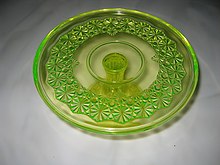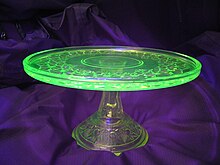Uranium glass


Uranium glass (also known as Vaseline glass) is a type of glass that contains uranium oxide compounds as a dye. These give the uranium glass light yellow (Anna yellow) to light green (Eleonoren green) transparent shades.
To distinguish between normal green glass and uranium glass, the object is held under black light . The yellowish to greenish uranium VI oxide compounds ( sodium diuranate , uranyl compounds ) then begin to fluoresce green .
historical development
The first production of uranium glass took place in the Roman Empire . Finds of corresponding mosaic stones are dated to the first century. The uranium ore used for production at that time was imported from North Africa. In the 17th and 18th centuries, Chinese glassmakers worked on the production of uranium glass. However, it remained with attempts. Uranium glass was not produced in large quantities until the 19th century. In addition to Bohemian glassworks , France , Belgium , England and the USA were the manufacturing centers. In the Bohemian town of Sankt Joachimsthal alone, a total of 1,600 tons of uranium dyes were produced by Adolf Patera's method up to 1898.
Health Risks and Precautions
If the uranium glass is handled responsibly, there is no immediate risk of danger, as the magnitude of the ionizing radiation emanating directly from the uranium glass can usually be assessed as relatively low.
In addition to the ionizing radiation emanating directly from the uranium, a chain of radiation-active elements such as radium or radon is created by uranium decay . The latter can escape as gas through microcracks in the glass and collect in poorly ventilated rooms.
According to measurements by the operator of the Pressglasrevue site , the uranium glasses in a collection reach 50 to 60 percent of the ambient radiation at the measurement location in Germany and only directly on the glass surface.
There are different views regarding a health risk from wearing necklaces with uranium glass beads: On the one hand, it can be stated that the alpha radiation emanating from uranium glass can only irradiate the uppermost layers of skin ( epidermis ) due to its low penetration ability and primarily the horny cell layer , the cells of which have already died are. The development of skin cancer as a result of the radiation has not yet been scientifically proven in this cell layer and therefore hardly to be expected. On the other hand, it should be noted that the horny cell layer on the neck is thinner than z. B. on the hands and feet. Thus, penetration of the radiation down to depths with skin cells that have not yet died cannot be ruled out.
To completely exclude the possibility of penetration into living tissue, uranium glass necklaces can be worn on items of clothing instead of directly on the skin. The ionizing effect of the emitted alpha radiation is kept away from the skin even by the thinnest pieces of clothing.
See also
literature
- Rudolf Geipel, Henning von Philipsborn: Natural radionuclides in everyday objects using the example of uranium glasses and uranium glazes . In: Radiation Protection Practice . tape 1 , 2001, ISSN 0947-434X .
- Henning von Philipsborn, Rudolf Geipel: uranium colors, uranium glasses, uranium glazes, radiometric, technical, historical (= series of publications by the Mining and Industrial Museum of Eastern Bavaria . Volume 46 ). Theuern 2005, ISBN 3-925690-55-7 .
Web links
- Rudolf Geipel: Background information on the subject of uranium glass (PDF)
- Articles about uranium glass, etc. a. with the historical development of uranium glass (PDF, 776 kB)
- Article with picture examples ( Memento from April 9, 2008 in the Internet Archive )
- Article (uranium glass photo gallery )
Individual evidence
- ↑ Vera Reith: On the radioactivity of uranium glasses. (No longer available online.) In: Pressglasrevue. Archived from the original on February 19, 2015 ; accessed on February 10, 2018 .

